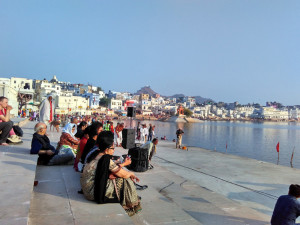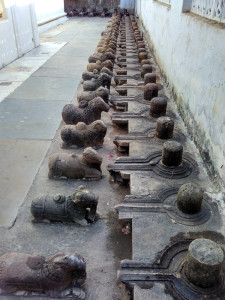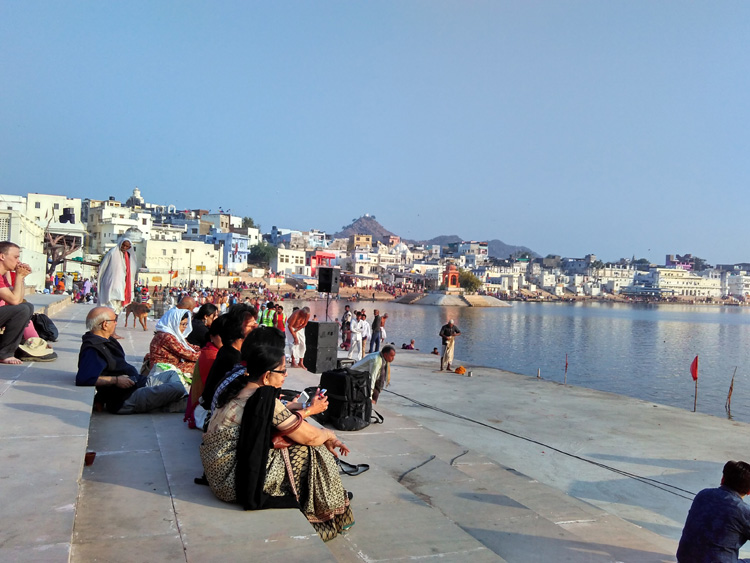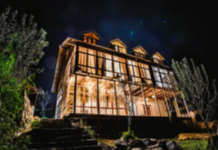By Ankit Sinha
PUSHKAR, Rajasthan– Of the multitude of tourist getaways located within the desert state of Rajasthan, Pushkar stands out with its reputation of a quaint, spiritual local that is frequented by Hindu devotees as a prominent pilgrimage spot. And it doesn’t disappoint.

This year, Shree Cement The Sacred festival, a three-day music and spirituality gala organised by Teamwork Arts, made an attempt to boost the festivities of Pushkar to epic proportions with a personalised experience of the town’s rich culture via a heritage walk.
Widely regarded as one of the oldest cities in India, Pushkar ranks as a quintessential spot for pilgrims who flock to the town in large numbers, especially during the auspicious time of Karthik Poornima, the full moon night of the Hindu lunar month of Karthik.
The history of Pushkar is replete with myths, but the most prominent and widely accepted lore is that it was created by Lord Brahma – the creator god in Hinduism – when he descended to earth. According to the myth, a flower (“pushpa”) fell off Brahma’s hand (“kar”), thus forming the sacred town of Pushkar.
Due to its intricate mythological associations, the exact date of Pushkar’s origin is unknown, but that only adds to the town’s mystique. With 52 sacred bathing ghats and hundreds of temples, the town indeed lives up to its reputation as a “tirtha raj” (the king of pilgrimage sites).

Among the essential places to visit, the Brahma temple should be put on top of the list. It is one of the few Brahma temples in the world, and its prominence grows manifold during Karthik Poornima, as thousands of devotees pay a visit to Pushkar to experience the religious fervour.
However, the moon temple in Chandra Ghat is one of the most interesting religious locations in Pushkar. According to Ravi Kant Sharma, who runs Roots of Pushkar Records and leads tourists on the unique heritage walk of the city, this is the only temple of its kind in the entire country.
“Back in the early 19th century, the family of the artisans of the Jaipur durbar – brothers Sundar Lal Kayasth and Shyam Lal Kayasth, faced problems due to some ancestral issues and unusual activities had increased. Thus, the astrologers recommended them to build two ghats, one for Chandrama (moon) and the other for Indra,” Sharma told IANS.
He added that both the ghats were made in 1830, with approximately Rs.14,000 back then.
The temples were made on the land owned by the priests there. But then that led to a tiff between the priests and the Kayasth brothers. After a court ruling, the temples were given over to the priests.
Besides this, the 108 Mahadev Temple is another stunning work of architecture. Living up to its name, the temple houses 108 small Shiva lingas along with statues of Nandi.
Another Shiva temple that captivates tourists’ attention is the Atpateshvar Mahadev, which is located below the ground, in an antiquarian formation, which harkens to the late 17th-18th century.
The rustic town is also renowned for the annual Pushkar Camel Fair, a livestock and camel fair, which was held during November 18-25 this year. Tens of thousands of camels and several thousand people flock to this spectacular event every year.
The easiest and fastest way to reach Pushkar is by car from Ajmer. The Ajmer Shatabdi, that links Delhi and Ajmer, is convenient for traveling there, especially if you wish to avoid taking flights. The over six-hour train journey is memorable in itself as you get to see picturesque farms and countryside while travelling.
If there is no traffic on the streets, one can reach Pushkar from the Ajmer railway station within an hour. The various heritage hotels there and other guest houses make tourists’ stay worthwile. But it is advisable to make bookings well in advance during Karthik Poornima due to high footfall.













